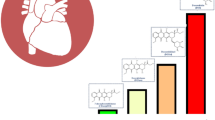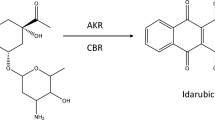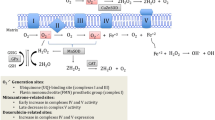Abstract
Mitoxantrone (MTX) is an antitumor agent that causes cardiotoxicity in 18 % patients. The metabolic profile of MTX was assessed after incubation of 100 μM MTX with hepatic S9 fraction isolated from rats. The presence of MTX and its metabolites was also assessed in vivo through the analysis of liver and heart extracts of MTX-treated rats. The cytotoxic effects of MTX and MTX metabolites were evaluated in the H9c2 cells after 24-h incubation with MTX alone and MTX + metabolites. The influence of CYP450- and CYP2E1-mediated metabolism for the cytotoxicity of MTX was assessed after 96-h incubation with MTX (100 nM and 1 μM) in the presence/absence of CYP450 or CYP2E1 inhibitors. After 4-h incubation in supplemented S9 fraction, the MTX content was 35 % lower and 5 metabolites were identified: an acetoxy ester derivative (never described before), two glutathione conjugates, a monocarboxylic acid derivative, and the naphtoquinoxaline, the later commonly related to MTX pharmacological effects. The presence of MTX and naphtoquinoxaline metabolite was evidenced in vivo in liver and heart of MTX-treated rats. The cytotoxicity caused by MTX + metabolites was higher than that observed in the H9c2 cells incubated with non-metabolized MTX group. The co-incubation of MTX with CYP450 and CYP2E1 inhibitors partially prevented the cytotoxicity observed in the MTX groups incubated with H9c2 cells, highlighting that the metabolism of MTX is relevant for its undesirable effects. The naphtoquinoxaline metabolite is described in heart and liver in vivo, highlighting that this metabolite accumulates in these tissues. It was demonstrated that MTX P450-mediated metabolism contributed to MTX toxicity.





Similar content being viewed by others
Abbreviations
- DAD:
-
Photodiode array
- DAS:
-
Diallyl sulfide
- DMEM:
-
Dulbecco’s modified eagle’s medium
- DMSO:
-
Dimethyl sulfoxide
- ESI:
-
Electrospray ionization interface
- GSH:
-
Reduced glutathione
- LC:
-
Liquid chromatography
- MS:
-
Mass spectrometry
- MTT:
-
3-(4,5-dimethylthiazol-2-yl)-2,5-diphenyltetrazolium bromide
- MTP:
-
Metyrapone
- MTX:
-
Mitoxantrone
- β-NADPH:
-
β-Nicotinamide adenine dinucleotide phosphate
References
An G, Morris ME (2010) HPLC analysis of mitoxantrone in mouse plasma and tissues: application in a pharmacokinetic study. J Pharm Biomed Anal 51(3):750–753
Avasarala JR et al (2003) Rapid onset mitoxantrone-induced cardiotoxicity in secondary progressive multiple sclerosis. Mult Scler 9:59–62
Basra J et al (1985) Evidence for human liver mediated-free radical formation by doxorubicin and mitozantrone. Anticancer Drug Des 1:45–52
Batra VK et al (1986) Pharmacokinetics of mitoxantrone in man and laboratory animals. Drug Metab Rev 17:311–329
Blanz J et al (1991) Evidence for oxidative activation of mitoxantrone in human, pig, and rat. Drug Metab Dispos 19(5):871–880
Brandon EF et al (2003) An update on in vitro test methods in human hepatic drug biotransformation research: pros and cons. Toxicol Appl Pharmacol 189(3):233–246
Brück TB, Brück DW (2011) Oxidative metabolism of the anti-cancer agent mitoxantrone by horseradish, lacto-and lignin peroxidase. Biochimie 93(2):217–226
Butler J, Hoey BM (1987) Are reduced quinones necessarily involved in the antitumour activity of quinone drugs? Br J Cancer 8:53–59
Canal P et al (1993) Plasma and cellular pharmacokinetics of mitoxantrone in high-dose chemotherapeutic regimen for refractory lymphomas. Cancer Res 53(20):4850–4854
Duthie SJ, Grant MH (1989) The role of reductive and oxidative metabolism in the toxicity of mitoxantrone, adriamycin and menadione in human liver derived Hep G2 hepatoma cells. Br J Cancer 60(4):566–571
Ehninger G et al (1990) Pharmacokinetics and metabolism of mitoxantrone. A review. Clin Pharmacokinet 18(5):365–380
Feofanov A et al (1997) Quantitative confocal spectral imaging analysis of mitoxantrone within living K562 cells: intracellular accumulation and distribution of monomers, aggregates, naphtoquinoxaline metabolite, and drug-target complexes. Biophys J 73(6):3328–3336
Fisher GR, Patterson LH (1992) Lack of involvement of reactive oxygen in the cytotoxicity of mitoxantrone, CI941 and ametantrone in MCF-7 cells: comparison with doxorubicin. Cancer Chemother Pharmacol 30(6):451–458
Fisher G, Patterson LH, Gutierrez PL (1993) A comparison of free radical formation by quinone anti-tumour agents in MCF-7 cells and the role of NAD(P)H (quinone-acceptor) oxidoreductase (DT-diaphorase). Chem Biol Interact 88:137–153
Hsin L-W et al (2008) Synthesis, DNA binding, and cytotoxicity of 1,4-bis(2-amino-ethylamino)anthraquinone-amino acid conjugates. Bioorg Med Chem 16(2):1006–1014
Jia L, Liu X (2007) The conduct of drug metabolism studies considered good practice (II): in vitro experiments. Curr Drug Metab 8(8):822–829
Khan SN et al (2010) Effect of mitoxantrone on proliferation dynamics and cell cycle progression. Biosci Rep 30(6):375–381
Kostrzewa-Nowak D et al (2007) Bioreductive activation of mitoxantrone by NADPH cytochrome P-450 reductase. Implications for increasing its ability to inhibit the growth of sensitive and multidrug resistant leukaemia HL60 cells. Cancer Lett 245(1–2):252–262
Li SJ, Rodgers EH, Grant MH (1995) The activity of xenobiotic enzymes and the cytotoxicity of mitoxantrone in MCF 7 human breast cancer cells treated with inducing agents. Chem Biol Interact 97(2):101–118
Lowry OH, Rosebrough NJ, Farr AL, Randall RJ (1951) Protein measurement with the folin phenol reagent, J Biol Chem (193):265–272
Mewes K et al (1993) Cytochrome P-450-induced cytotoxicity of mitoxantrone by formation of electrophilic intermediates. Cancer Res 53(21):5135–5142
Neuhaus O, Kieseier BC, Hartung H-P (2006) Therapeutic role of mitoxantrone in multiple sclerosis. Pharmacol Ther 109(1–2):198–209
Novak RF, Kharasch ED (1985) Mitoxantrone: propensity for free radical formation and lipid peroxidation-implications for cardiotoxicity. Invest New Drugs 3(2):95–99
Panousis C, Kettle AJ, Phillips DR (1997) Neutrophil-mediated activation of mitoxantrone to metabolites which form adducts with DNA. Cancer Lett 113(1–2):173–178
Parkinson A, Ogilvie B (2008) Biotransformation of xenobiotics. In: Klaassen C (ed) Casarett & Doull’s toxicology: the basic science of poisons. McGraw-Hill, New York, p 1331
Pontes H et al (2010) Metabolic interactions between ethanol and MDMA in primary cultured rat hepatocytes. Toxicology 270(2–3):150–157
Richard B et al (1991) Interspecies variability in mitoxantrone metabolism using primary cultures of hepatocytes isolated from rat, rabbit and humans. Biochem Pharmacol 41(2):255–262
Rossato LG et al (2011) Structural isomerization of synephrine influences its uptake and ensuing glutathione depletion in rat-isolated cardiomyocytes. Arch Toxicol 85(8):929–939
Sardão V et al (2009a) Doxorubicin-induced mitochondrial dysfunction is secondary to nuclear p53 activation in H9c2 cardiomyoblasts. Cancer Chemother Pharmacol 64(4):811–827
Sardão V et al (2009b) Morphological alterations induced by doxorubicin on H9c2 myoblasts: nuclear, mitochondrial, and cytoskeletal targets. Cell Biol Toxicol 25(3):227–243
Seiter K (2005) Toxicity of the topoisomerase II inhibitors. Expert Opin Drug Saf 4(2):219–234
Shipp NG et al (1993) Characterization of experimental mitoxantrone cardiotoxicity and its partial inhibition by ICRF-187 in cultured neonatal rat heart cells. Cancer Res 53(3):550–556
Silva R et al (2011) In vitro study of P-glycoprotein induction as an antidotal pathway to prevent cytotoxicity in Caco-2 cells. Arch Toxicol 85(4):315–326
Wolf CR, Macpherson JS, Smyth JF (1986) Evidence for the metabolism of mitozantrone by microsomal glutathione transferases and 3-methylcholanthrene-inducible glucuronosyl transferases. Biochem Pharmacol 35(9):1577–1581
Yoshihara S et al (2001) Metabolic activation of bisphenol A by rat liver S9 fraction. Toxicol Sci 62(2):221–227
Zordoky BNM, El-Kadi AOS (2007) H9c2 cell line is a valuable in vitro model to study the drug metabolizing enzymes in the heart. J Pharmacol Toxicol Methods 56(3):317–322
Acknowledgments
Authors are grateful to Dr. Zelia dos Santos Azevedo, from Faculty of Sciences, University of Porto, for gently lend us the LC/DAD-ESI/MS and for all precious technical assistance. This work was supported by the Fundação para a Ciência e Tecnologia (FCT)—project [EXPL/DTP-FTO/0290/2012]—QREN initiative with EU/FEDER financing through COMPETE—Operational Programme for Competitiveness Factors. LGR and VMC thank FCT for their Ph.D. grant (SFRH/BD/63473/2009) and Post-doc grant (SFRH/BPD/63746/2009), respectively. The authors are also grateful to Fundação para a Ciência e a Tecnologia (FCT) for Grant No. PEst-C/EQB/LA0006/2011
Author information
Authors and Affiliations
Corresponding authors
Electronic supplementary material
Below is the link to the electronic supplementary material.
Rights and permissions
About this article
Cite this article
Rossato, L.G., Costa, V.M., de Pinho, P.G. et al. The metabolic profile of mitoxantrone and its relation with mitoxantrone-induced cardiotoxicity. Arch Toxicol 87, 1809–1820 (2013). https://doi.org/10.1007/s00204-013-1040-6
Received:
Accepted:
Published:
Issue Date:
DOI: https://doi.org/10.1007/s00204-013-1040-6




